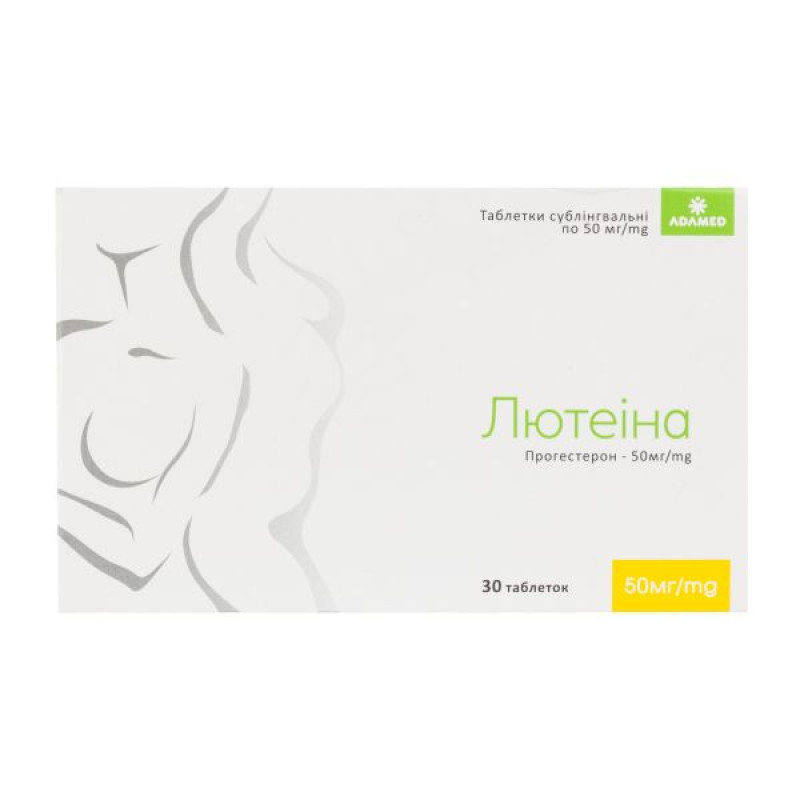Lutein sublingual tablets 50 mg No. 30

Instructions for Lutein sublingual tablets 50 mg No. 30
Composition
active ingredient: micronized progesterone;
1 tablet contains 50 mg of micronized progesterone;
excipients: lactose monohydrate, potato starch, polyvinylpyrrolidone, ethylcellulose, talc, vanillin, magnesium stearate.
Dosage form
Sublingual tablets.
Main physicochemical properties: tablets without a shell, white in color, concave on one side, convex on the other, with a diameter of 9 mm ± 0.1 mm.
Pharmacotherapeutic group
Hormones of the sex glands and drugs used in pathologies of the genital area. Progestogens, pregnen derivatives. ATX code G03D A04.
Pharmacological properties
Pharmacodynamics
Progesterone in Lutein is a synthetically derived natural hormone of the corpus luteum of the ovary. Under physiological conditions, progesterone is produced in the luteinized granular cells of the corpus luteum of the ovary, in the syncytia of the placental villi at approximately 14-18 weeks of pregnancy, in the fasciculus and reticular layers of the adrenal cortex, and in the central nervous system. The corpus luteum of the ovary produces progesterone in the second phase of the sexual cycle in an amount that increases from 5 to 55 mg per day on days 20-22 of the cycle and decreases by day 27 of the cycle. The secretion of progesterone by the corpus luteum occurs pulsatilely.
In the female body, progesterone acts through specific receptors located in the uterus, mammary glands, central nervous system and pituitary gland. The human receptor for progesterone has two isoforms: PR-A and PR-B (PR-progesterone). PR-A can act as both an inhibitor and an activator of transcription, which makes possible various tissue effects. The most important effects of progesterone on the reproductive organs are: facilitation of ovulation by proteolysis of the Graafian follicle wall; secretory change of the endometrium, which makes possible the implantation of a fertilized egg; inhibition of excessive endometrial hypertrophy under the influence of estrogens; cyclic changes in the epithelium of the fallopian tubes, cervix and vagina. Progesterone acts synergistically with estrogens on the mammary gland, stimulating the growth of glandular follicles and ductal epithelium, as well as participating in the expression of receptors necessary for lactation. Progesterone is a hormone necessary for the gestation of pregnancy throughout its entire duration: it inhibits the immunological response of the uterus to fetal antigens, is a substrate for the production of fetal gluco- and mineralocorticoids, initiates labor, and eliminates the spontaneous contractile activity of the pregnant uterus.
Other metabolic effects of progesterone include: increased body temperature, stimulation of respiration, decreased concentration of amino acids in blood plasma, increased concentration of glucagon and decreased hypoglycemic action of insulin, increased excretion of calcium and phosphorus, antiandrogenic effect, which consists in blocking the activity of 5-alpha-reductase, which converts testosterone to dihydrotestosterone, and androgen receptors, diuretic effect by blocking the action of aldosterone in the distal tubule of the nephron.
The precursor of progesterone is cholesterol, synthesized from acetyl-coenzyme A (acetyl-CoA), as well as cholesterol derived from low-density lipoproteins (LDL). In the inner mitochondrial membrane, cholesterol is converted into pregnenolone, which is the direct precursor of progesterone, under the influence of LH (luteinizing hormone, lutropin).
Pharmacokinetics
Absorption. After sublingual administration, some progesterone is absorbed through the oral mucosa and does not undergo first-pass absorption. During the first hour after sublingual administration, the mean serum concentration of progesterone is higher than after oral administration. The portion of progesterone that is not absorbed through the oral mucosa passes through the gastrointestinal tract and undergoes first-pass absorption.
Metabolism. Progesterone metabolism occurs primarily in the liver (about 90% of the hormone undergoes first-pass metabolism when administered orally, but the dose absorbed sublingually does not undergo first-pass metabolism). The metabolites, pregnanediols and pregnanols, are converted in the liver to glucuronates and sulfates. Progesterone metabolites excreted via the biliary tract may be further modified by reduction, dehydroxylation, and epimerization. Metabolites are excreted primarily via the biliary and urinary tracts. Metabolites excreted via the biliary tract may be further metabolized in the liver or excreted in the feces.
Elimination. About 96-99% of progesterone is bound to plasma proteins: about 50-54% to albumin and 43-48% to transcortin (corticosteroid-binding globulin CBG). Progesterone is well absorbed when administered sublingually. After sublingual administration of 100 mg of progesterone, the concentration of the hormone in the blood plasma reaches a maximum level after about 1-4 hours, and after 200 mg - after about 2-6 hours. The half-life of progesterone taken sublingually (as well as orally) is about 6-7 hours.
It is believed that the progesterone concentration measured in the middle of the luteal phase of the cycle, necessary for secretory change of the endometrium, should be about 12 - 15 ng / ml. However, often the concentration of progesterone in the blood plasma does not correlate with the histological state of the endometrium. To determine the insufficiency of the luteal phase, in addition to determining the concentration of progesterone in the blood serum, it is necessary to confirm by histopathological examination the delay of endometrial maturation by at least 3 days in relation to the calculated day of the cycle. Also essential is a reduction in the duration of the luteal phase to less than 10 days.
Indication
Treatment of endogenous progesterone deficiency in the form of menstrual cycle disorders, secondary amenorrhea, anovulatory cycles, premenstrual syndrome, functional uterine bleeding. In artificial insemination, infertility associated with luteal insufficiency, habitual miscarriage and the threat of spontaneous abortion in progesterone deficiency, corpus luteum insufficiency, secondary amenorrhea, to prevent endometrial hypertrophy in women taking estrogens (for example, in hormone replacement therapy).
Contraindication
Hypersensitivity to the components of the drug. Breastfeeding. Suspected or confirmed neoplasia of the breast or genitals. Unspecified bleeding from the genital tract.
Severe liver dysfunction. Cholestatic jaundice. Rotor syndrome and Dubin-Johnson syndrome. Thromboembolic venous disease (deep vein thrombophlebitis, pulmonary embolism). Current or past thromboembolic disorders in the arteries (angina pectoris, myocardial infarction). Miscarriages, as well as the presence of remnants of a miscarriage in the uterine cavity. Porphyria, cerebral hemorrhage.
Interaction with other medicinal products and other types of interactions
Progesterone metabolism may be accelerated by concomitant use of substances that induce cytochrome P450 enzymes, such as antiepileptic and antibacterial drugs, and herbal preparations. In vitro studies have shown that drugs that reduce cytochrome P450 activity (e.g. ketoconazole) may slow down progesterone metabolism. The clinical significance of this phenomenon is unknown. Progesterone administration may increase plasma concentrations of cyclosporine.
Some antibiotics (e.g. ampicillin, tetracycline) can cause changes in the intestinal microflora, resulting in a change in the enterohepatic steroid cycle.
Strong inducers of hepatic enzymes, namely: barbiturates, antiepileptic drugs (phenytoin), rifampicin, phenylbutazone, spironolactone, griseofulvin, nevirapine, efavirenz, carbamazepine, cause increased metabolism at the hepatic level. Ritonavir and nelfinavir are known as strong inhibitors of cytochrome enzymes, exhibit enzyme-inducing properties when used simultaneously with steroid hormones.
All progestins may reduce glucose tolerance, which may require an increase in the daily dose of insulin and other antidiabetic agents in patients with diabetes.
Progesterone bioavailability can be reduced by smoking and increased by alcohol consumption.
No clinically significant interactions of progesterone with other drugs have been confirmed.
Application features
Before starting treatment, a thorough gynecological examination should be performed, family history should be reviewed, breast palpation and cytological examination should be performed.
In case of uterine bleeding, before starting treatment, a diagnosis should be made to exclude organic causes of bleeding.
Patients with a history of depression require special monitoring, as progesterone may exacerbate depression. If severe depression occurs, the drug should be discontinued.
The use of the drug in premenopausal patients may mask the onset of menopause.
The drug should not be used in patients with severe liver dysfunction. Patients with liver disease should be under the supervision of a physician during treatment with the drug. In individuals with diabetes mellitus or impaired glucose tolerance, progesterone may reduce glucose tolerance.
Lutein does not have a contraceptive effect. If progesterone is used for reasons other than infertility, it is advisable to use contraceptives at the same time.
Especially carefully appoint patients after transferred thromboembolic disorders: current or transferred arterial or venous thromboembolic disorders, including deep vein thrombophlebitis, thromboembolism of the lenagh artery, angina pectoris, myocardial infarction. Patients should be under constant supervision of a doctor, it is necessary to conduct periodic examinations. Patients should be warned about the mandatory notification of the doctor if changes in the mammary gland are detected.
If treatment is started too early in the menstrual cycle, cycle shortening or bleeding may occur.
In case of uterine bleeding, do not prescribe the drug without clarifying the cause, in particular during endometrial examination.
Before prescribing the drug, patients with a family history of neoplasms and patients with recurrent cholestasis or persistent itching during pregnancy, impaired liver function, heart or kidney failure, fibrocystic mastopathy, epilepsy, asthma, otosclerosis, diabetes mellitus, multiple sclerosis, systemic lupus erythematosus should be carefully examined.
Due to the thromboembolic and metabolic risk, which cannot be completely ruled out, the drug should be discontinued in the event of:
visual disturbances, such as vision loss, double vision, retinal vascular lesions, ptosis, optic disc edema; thromboembolic venous or thrombotic complications, regardless of the site of the lesion; severe headache, migraine.
If amenorrhea occurs during treatment, pregnancy, which may be the cause of amenorrhea, should be confirmed or ruled out.
More than half of early spontaneous abortions are caused by genetic complications. In addition, infectious manifestations and mechanical disorders can cause early abortions; the only justification for prescribing progesterone would then be to delay the expulsion of a dead fetus. Therefore, the prescription of progesterone on the recommendation of a doctor should be reserved for cases where progesterone secretion is insufficient.
Before starting treatment, the patient should undergo a thorough medical and accurate gynecological examination, including intravaginal and mammological examination, Papanicolaou smear, taking into account the anamnesis, contraindications and precautions for use. During treatment, regular check-ups with a doctor are recommended.
Women receiving hormone replacement therapy should carefully evaluate all risks/benefits associated with the therapy.
In patients with postmenopausal symptoms who are receiving or have received hormone replacement therapy (HRT), there is a slight to moderate increase in the likelihood of being diagnosed with breast cancer. This may be due to early diagnosis of patients or the actual benefit of HRT, as well as a combination of both. The risk of being diagnosed with breast cancer increases with increasing duration of treatment and returns to baseline values 5 years after stopping HRT. Breast cancer diagnosed in patients who are receiving or have recently received HRT is less invasive than that occurring in women who have not received HRT. The doctor should discuss the higher likelihood of developing breast cancer with patients who will receive long-term hormone therapy when assessing the benefits of HRT.
The drug should not be taken with food, but should be taken before bedtime. Simultaneous intake of food increases the bioavailability of the drug.
Lutein contains lactose, so the drug should not be used in patients with hereditary forms of galactose intolerance, lactase deficiency (Lapp type) or glucose-galactose malabsorption syndrome.
Ability to influence reaction speed when driving vehicles or other mechanisms
No specific studies have been conducted on the effect of progesterone on the ability to drive or operate machinery, but given that in rare cases, dizziness, drowsiness, impaired concentration and attention may occur when using progesterone, the driver or operator of other mechanisms should be warned about such undesirable effects. Taking the tablets before bedtime allows you to avoid these unpleasant consequences.
Use during pregnancy or breastfeeding
Lutein can be used in the first trimester of pregnancy. The drug does not have masculinizing, virilizing, corticosteroid and anabolic effects. There is insufficient data on the use of progesterone in the second and third trimesters of pregnancy.
There is evidence of a possible risk of hypospadias when progestogens are used during pregnancy to prevent habitual miscarriage or threatened miscarriage due to luteal insufficiency, and the patient should be informed of this.
Progesterone passes into breast milk, so the use of the drug during breastfeeding is contraindicated.
Method of administration and doses
Lutein doses in each individual case should be set individually for each patient, depending on the indications and therapeutic effect.
For menstrual cycle disorders and premenstrual syndrome, use 50 mg of progesterone 3-4 times a day sublingually. Treatment lasts for 3-6 consecutive cycles.
To prevent endometrial hypertrophy (with hormone replacement therapy) in combination with estrogens, 50 mg of progesterone should most often be used 3-4 times a day sublingually. In prolonged intermittent regimens, the drug should be used sublingually during the last 12-14 days of the 28-day cycle.
For prolonged continuous regimens, progesterone should be administered daily without interruption.
The dose of progesterone should depend on the dose of estrogens so as to protect the endometrium from the proliferative effects of estrogens.
In the treatment of functional uterine bleeding, 50 mg of progesterone should be administered sublingually 3-4 times a day from the 15th to the 25th day of the cycle. Treatment should be continued for 2-3 consecutive months.
In case of habitual miscarriage and the threat of spontaneous abortion, anovulatory and induced cycles, use 100 mg of progesterone 3-4 times a day sublingually.
In case of habitual miscarriage, progesterone should be started during the cycle in which pregnancy is planned, even earlier (pre-pregnancy preparation 3-4 months in advance). Treatment should be continued continuously until approximately the 18th-20th week of pregnancy.
In in vitro fertilization (IVF) programs, use 100-150 mg of progesterone 3-4 times a day sublingually.
Children
Not recommended for use in children.
Overdose
Most often, symptoms of overdose can manifest as: drowsiness, dizziness, nausea, depression.
Symptoms usually resolve on their own after reducing the dose of the drug.
In case of overdose, the drug should be discontinued and symptomatic treatment should be applied.
Adverse reactions
During the use of Lutein, which contains progesterone identical to the endogenous hormone, side effects were rarely observed, with the exception of symptoms occurring in case of overdose.
The adverse reactions listed below are classified by system organ class and frequency: very common (≥ 1/10), common (≥ 1/100 and < 1/10), uncommon (≥ 1/1,000 and < 1/100), rare (≥ 1/10,000 and < 1/1,000), very rare (< 1/10,000).
Nervous system disorders: uncommon: drowsiness, headache and dizziness.
On the part of the psyche: infrequently: impaired concentration and attention, feeling of fear, depression.
From the reproductive system: rarely: abnormal uterine bleeding, dysmenorrhea, spotting.
Skin and subcutaneous tissue disorders: rare: anaphylactic reactions, skin redness, acne, allergic reactions.
Vascular disorders: Rare: gingival bleeding, thrombosis, venous thromboembolism, pulmonary embolism
Gastrointestinal: infrequently: nausea; rarely: dry mouth, gastrointestinal disorders, vomiting, diarrhea, constipation
Hepatobiliary disorders: rare: cholestatic jaundice.
Metabolism and digestion disorders: rare: body weight fluctuations.
Other disorders: fluid retention, hyperthermia.
Drowsiness and/or transient dizziness are observed especially in the case of concomitant hypoestrogenism. Reducing the dose of the drug or increasing the dose of estrogen immediately eliminates these phenomena without reducing the therapeutic effect.
If treatment is started too early in the menstrual cycle, especially before day 15, cycle shortening or spotting may occur.
Expiration date
3 years.
Storage conditions
Store in original packaging at a temperature below 25 ° C. Keep out of the reach of children.
Packaging
15 tablets in a blister; 2 blisters in a cardboard box with labeling in Ukrainian.
Vacation category
According to the recipe.
Producer
Adamed Pharma JSC, Poland.
Location of the manufacturer and its business address
St. Marsh. J. Pilsudskiego 5, 95-200, Pabianice, Poland.
There are no reviews for this product.
There are no reviews for this product, be the first to leave your review.
No questions about this product, be the first and ask your question.


















